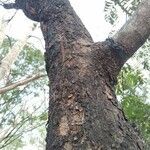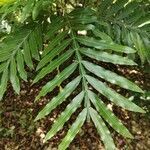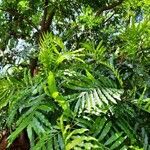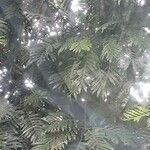Slender tree 4.5–20(–30) m. tall; bark smooth, whitish.. Petiole winged, 1.5–11 cm. long; rhachis 15–30 cm. long, winged each side to 1 cm. wide, tapering below each leaflet pair; leaflets in 5–10 pairs, sessile, lanceolate to linear or narrowly oblong-elliptic, 5–16 cm. long, 0.5–4 cm. wide, acute, entire but crisped-undulate at the margin, glabrous, resinous when young; lateral nerves in 30–50 pairs, faint.. Inflorescence 6–20 cm. long; pedicels 2–4 mm. long.. Sepals 1.3 mm. long, herbaceous, puberulous inside, ciliate.. Petals yellow, 1.3 mm. long, ciliate, apparently caducous.. Stamens exserted from the calyx; staminodes not exserted.. Ovary 2-locular with 2 ovules, one only developing.. Fruit ellipsoid or subglobose, 9–10 mm. long, 6–8 mm. wide, with persistent style and reflexed sepals.. Fig. 2.
Trees. Indumentum sparse, sericeous, most parts with scale hairs. Leaves alternate, paripinnate, 5-many-jugate, rachis (broadly) winged. Leaflets narrow, long, shiny; nerves many, straight, scalar-iform; domatia absent. Inflorescences axillary to pseudoterminal panicles. Flowers unisexual. Sepals 5, equal, ovate, ciliate, with scale hairs outside. Petals 5, elliptic, about as large as sepals, ciliate; scales and auricles absent. Disc flat, complete, 5-lobed, densely pilose. Stamens 5, glabrous, exserted in male flowers, anthers not opening in female flowers. Ovary compressed-globose, finely hairy at base, 2-locular, rudimentary in male flowers; style short; stigma 2-lobed; one ovule per locule. Fruit a drupe, smooth, glabrous, thin-walled. Seeds without fleshy structure.
A tree. It grows 12-25 m tall. It has a round crown. The leaves are compound and large. They have 12-16 leaflets. Each leaflet is 10 to 15 cm long and narrow. The flowers are small and white. The fruit is fleshy and 1 cm across. They are oval, purple and shiny.
Usually a small tree up to 6–7 m. tall or shrub; bark variously described as smooth and greyish-brown or rough and dull chocolate-brown; branchlets





